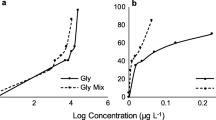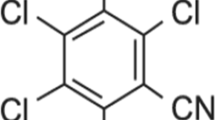Abstract
This paper reports on the chronic effects of a mixture of the insecticides chlorpyrifos and lindane in freshwater microcosms. Chronic treatment levels corresponding to concentrations of 0, 0.005, 0.01, 0.05, 0.1 and 0.5 times the LC50 of the most sensitive standard test organism were evaluated. The zooplankton community structure was altered from the 0.05*LC50 treatment level upwards. Cladocerans were the most susceptible group, followed by Copepoda and Ostracoda. Rotifera increased in abundance at the higher treatment levels. Increased abundance of some phytoplankton taxa and increased chlorophyll-a levels were found at the two highest treatment levels, most probably a consequence of decreased grazing pressure. Threshold levels for the mixture, both at population and community/ecosystem level, corresponded well with those reported in the literature for the individual compounds. The overall risk assessment indicates no antagonistic or synergistic effects of the mixture at ecosystem level. It was found that the safety factors set by the Uniform Principles for individual compounds also ensure protection against chronic exposure to a mixture of insecticides at community level, though not always at species level.
Similar content being viewed by others
References
Aldenberg, T. and Slob, W. (1993). Confidence limits for hazardous concentrations based on logistically distributed NOEC toxicity data. Ecotoxicol. Environ. Safety 25, 48–63.
AQUIRE (1998). AQUIRE, (AQUatic toxicity Information REtrieval) database consulted on July 13th, 1998 on web page http: //www.epa.gov/med/databases/databases.html#aquire.
Barron, M.G. and Woodburn, K.B. (1995). Ecotoxicology of chlorpyrifos. Rev. Environ. Contaminat. Toxicol. 143, 1–93.
Biever, R.C., Giddings, J.M., Kiamos, M., Annunziato, M.F., Meyerhoff, R. and Racke, K. (1994). Effects of chlorpyrifos on aquatic microcosms over a range of off-target drift exposure levels. Brighton, UK: Brighton Crop Protection Conference—Pests and Diseases, 1367–72.
Bluzat, R. and Seuge, J. (1979). Effects of three insecticides (lindane, fenthion and carbaryl) on the acute toxicity to four aquatic invertebrate species and the chronic toxicity to the pulmonate mollusc Lymnaea. Environ. Pollut. 18, 51–70.
Boyle, T.P. and Fairchild, J.F. (1997). The role of mesocosm studies in ecological risk analysis. Ecol. Appl. 7, 1099–102.
Brock, T.C.M., Crum, S.J.H., Van Wijngaarden, R.P.A., Budde, B.J., Tijink, J., Zuppelli, A. and Leeuwangh, P. (1992). Fate and effects of the insecticide Dursban® 4E in indoor Elodea-dominated and macrophyte-free model ecosystems: I Fate and primary effects of the active ingredient chlorpyrifos. Archi. Environ. Contaminat. Toxicol. 23, 69–84.
Brock, T.C.M., Vet, J.J.R.M., Kerkhofs, M.J.J., Lijzen, J., Van Zuilenkom, W.J. and Gylstra, R. (1993). Fate and effects of the insecticide Dursban® 4E in indoor Elodea-dominated and macrophyte-free model ecosystems: III Aspects of ecosystem functioning. Arch. Environ. Contaminat. Toxicol. 25, 160–9.
Brock, T.C.M., Roijackers, R.M.M., Rollon, R., Bransen, F. and Van der Heyden, L. (1995). Effects of nutrient loading and insecticide application on the ecology of Elodea-dominated freshwater microcosms. II. Responses of macrophytes, periphyton and macroinvertebrate grazers. Archive für Hydrobiologie 134, 53–74.
Brock, T.C.M., Van Wijngaarden, R.P.A. and Van Geest, G.J. (2000). Ecological risks of pesticides in freshwater ecosystems Part 2: Insecticides. Alterra-report 089, Wageningen, The Netherlands: Alterra Green World Research.
Calamari, D., Galassi, S., Setti, F. and Vighi, M. (1983). Toxicity of selected chlorobenzenes to aquatic organisms. Chemosphere 12, 253–62.
Campbell, P.J., Arnold, D.J.S., Brock, T.C.M., Grandy, N.J., Heger, W., Heimbach, F., Maund, S.J. and Streloke, M. (1999). Guidance document on Higher tier Aquatic Risk Assessment for Pesticides (HARAP). Brussels, Belgium: SETAC-Europe.
Cuppen, J.G.M., Van den Brink, P.J., Van der Woude, H., Zwaardemaker, N. and Brock, T.C.M. (1997). Sensitivity of macrophyte-dominated freshwater microcosms to chronic levels of the herbicide linuron. II. Invertebrates and community metabolism. Ecotoxicol. Environ. Safety 38, 25–35.
Cuppen, J.G.M., Van den Brink, P.J., Uil, K.F., Camps, E. and Brock, T.C.M. (2000). Impact of the fungicide carbendazim in freshwater microcosms II Water quality, breakdown of Particulate Organic Matter and responses of macro-invertebrates. Aqua. Toxicol. 48, 233–50.
Cuppen, J.G.M., Crum, S.J.H., Van den Heuvel, H.H., Smidt, R.A. and Van den Brink, P.J. (2002) The effects of a mixture of two insecticides on freshwater microcosms. I. Fate of insecticides and responses of macroinvertebrates. Ecotoxicology 11, 19–34.
De Bruin, J., Busser, F., Seinen, W. and Hermens, J. (1989). Determination of octanol/water partition coefficients for hydrophobic organic chemicals with the “slow-stirring method”. Environ. Toxicol. Chem. 8, 499–512.
European Union, (1997). Council Directive 97/57/EC of September 21, 1997; Establishing Annex VI to Directive 91/414/EEC Concerning the Placing of Plant Protection Products on the Market. Official J. Eur. Commun. L265, 87–109.
Hanazato, T. (1998). Response of a zooplankton community to insecticide application in experimental ponds: a review and the implications of the effects of chemicals on the structure and functioning of freshwater communities. Environ. Pollut. 101, 361–73.
Hartgers, E.M., Aalderink, G.H., Van den Brink, P.J., Gylstra, R., Wiegman, J.W.F. and Brock, T.C.M. (1998). Ecotoxicological threshold levels of a mixture of herbicides (atrazine, diuron and metholachlor) in freshwater microcosms. Aquat. Ecol. 32, 135–52.
Johnson, W.W. and Finley, M.T. (1980). Handbook of Acute Toxicity of Chemicals to Fish and Aquatic Invertebrates. Resources Publications 137, Washington D.C.: Fish and Wildlife Service, U.S.D.I.
Kersting, K. and Van Wijngaarden, R.P.A. (1992). Effects of chlorpyrifos on a microecosystem. Environ. Toxicol. Chem. 11, 365–72.
Mayer, F.L. and Ellersieck, M.R. (1986). Manual of acute toxicity: interpretation and database for 410 chemicals and 66 species of freshwater animals. U.S. Fish and Wildlife Service Resource Publication 160, Washington D.C.: US Department of the Interior.
Mitchell, G.C., Bennett, D. and Pearson, N. (1993). Effects of lindane on macroinvertebrates and periphyton in outdoor artificial streams. Ecotoxicol. Environ. Safety 25, 90–102.
Moed, J.R. and Hallegraeff, G.M. (1978). Some problems in the estimation of chlorophyll-a and phaeopigments from pre-and post-acidification spectrophotometric measurements. Internationale Revue der gesamten Hydrobiologie 63, 787–800.
Moore, M.T., Huggett, D.B., Gillespie, W.B., Rodgers, J.H. and Cooper, C.M. (1998). Comparative toxicity of chlordane, chlorpyrifos, and aldicarb to four aquatic testing organisms. Arch. Environ. Contaminat. Toxicol. 34, 152–7.
Peither, A., Jüttner, I., Kettrup, A. and Lay, J.P. (1996). A pond mesocosm study to determine direct and indirect effects of lindane on a natural zooplankton community. Environ. Pollut. 93, 49–56.
Stay, F.S., Flum, T.E., Shannon, L.J. and Yount, J.D. (1989). An assessment of the precision and accuracy of SAM and MFC microcosms exposed to toxicants. In U.M. Cowgill and L.R. Williams (eds), Aquatic Toxicology and Hazard Assessment, 12th Symposium. STP 1027, pp. 189–203. Philadelphia, PA: American Society for Testing and Materials.
Stephenson, R.R. (1983). Effects of water hardness, water temperature and size of test organism on the susceptibility of the freshwater shrimp Gammarus pulex (L.) to toxicants. Bull. Environ. Contaminat. Toxicol. 31, 459–66.
Van den Brink, P.J., Van Donk, E., Gylstra, R., Crum, S.J.H. and Brock, T.C.M. (1995). Effects of chronic low concentrations of the pesticides chlorpyrifos and atrazine in indoor freshwater microcosms. Chemosphere 31, 3181–200.
Van den Brink, P.J., Van Wijngaarden, R.P.A., Lucassen, W.G.H., Brock, T.C.M. and Leeuwangh, P. (1996). Effects of the insecticide Dursban 4E (active ingredient chlorpyrifos) in outdoor experimental ditches: II. Invertebrate community responses and recovery. Environ. Toxicol. Chem. 15, 1143–53.
Van den Brink, P.J. and Ter Braak, C.J.F. (1998). Multivariate analysis of stress in experimental ecosystems by Principal Response Curves and similarity analysis. Aquat. Ecol. 32, 163–78.
Van den Brink, P.J. and Ter Braak, C.J.F. (1999). Principal response curves: analysis of time-dependent multivariate responses of biological community to stress. Environ. Toxicol. Chem. 18, 138–48.
Van den Brink, P.J., Posthuma, L. and Brock, T.C.M. (2002). The value of the Species Sensitivity Distribution concept for predicting field effects: (non-)confirmation of the concept using semi-field experiments. In L. Posthuma, T.P. Traas and G.W. Suter (eds), The Use of Species Sensitivity Distributions in Ecotoxicology. Boca Raton, FL: Lewis Publishers.
Van Donk, E., Abdel-Hamid, M.I., Faafeng, B.A. and Källqvist, T. (1992). Effects of Dursban® 4E and its carrier on three algal species during exponential and P-limited growth. Aquat. Toxicol. 23, 181–92.
Van Donk, E., Prins, H., Voogd, H.M., Crum, S.J.H. and Brock, T.C.M. (1995). Effects of nutrient loading and insecticide application on the ecology of Elodea-dominated freshwater microcosms I Responses of plankton and zooplanktivorous insects. Archiv für Hydrobiologie 133, 417–39.
Van Straalen, N.M. and Denneman, C.A.J. (1989). Ecotoxicological evaluation of soil quality criteria. Ecotoxicol. Environ. Safety 18, 241–51.
Van Wijngaarden, R.P.A., Leeuwangh, P., Lucassen, W.G.H., Romijn, K., Ronday, R., Van der Velde, R. and Willigenburg, W. (1993). Acute toxicity of chlorpyrifos to fish, a newt and aquatic invertebrates. Bull. Environ. Contaminat. Toxicol. 51, 716–23.
Versteeg, D.J., Belanger, S.E. and Carr, G.J. (1999). Understanding single-species and model ecosystem sensitivity: data based comparison. Environ. Toxicol. Chem. 18, 1329–46.
Ward, S., Arthington, A.H. and Pusey, B.J. (1995). The effects of a chronic application of chlorpyrifos on the macroinvertebrate fauna in an outdoor artificial stream system: species responses. Ecotoxicol. Environ. Safety 30, 2–23.
Williams, D.A. (1972). The comparison of several dose levels with zero dose control. Biometrics 28, 519–31
Author information
Authors and Affiliations
Corresponding author
Rights and permissions
About this article
Cite this article
Van den Brink, P.J., Hartgers, E.M., Gylstra, R. et al. Effects of a Mixture of Two Insecticides in Freshwater Microcosms: II. Responses of Plankton and Ecological Risk Assessment. Ecotoxicology 11, 181–197 (2002). https://doi.org/10.1023/A:1015422815401
Issue Date:
DOI: https://doi.org/10.1023/A:1015422815401




